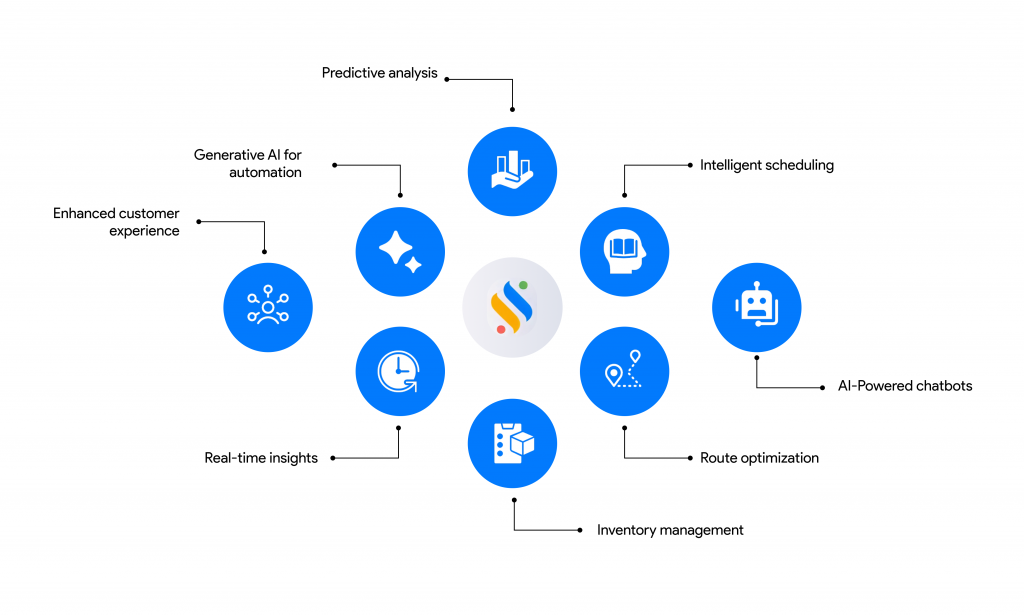
Field force management is quite a challenging task you may have ever witnessed.
Your compensation depends on how well you manage your field workforce and enable them to achieve faster response times.
For some managers, it feels like a nightmare due to endless calls, constant follow-ups, and piles of tracking reports. Others find it easier because they use smart tools that assist them in better field team management. It eventually improves their customer experience.
You might not know, but they manage it more efficiently thanks to advanced technology – AI-powered field service management software. At least 90% of decision-makers are investing for the same reason.
It’s the time you gear up too. To give you an overview, this blog covers why and how this innovation is revolutionizing on-ground operations.
Why is AI in Field Force Automation So Important?
Table of Contents
The problem is caused initially by out-of-date tracking. What starts as just a simple scheduling gap or missing update can quickly spiral into slowing the entire deal cycle. Here’s what happens without AI field force management that everyone faces:
- Manager’s blind spots: Disruptions from calls and delays can break down lead and customer targeting. Momentum is lost, and valuable opportunities slip away.
- Mobile worker inefficiencies: Reps waste hours on longer travel or a lack of resources. By the time the issue is noticed, the first-time fix rate takes longer, and productivity declines.
- Customers’ frustration: Field reps’ burnout, delayed or repeat visits, and long response times can quickly break customers’ trust. It results in more customer complaints, reduced service reliability, and eventually, customer loss.
If not fixed in time, these problems can drag down productivity and weaken the trust between field teams and their managers. Thereafter, it harms customer relationships and boosts overspending in the field.
That’s why adopting AI for field force automation is a core strategy. It brings managers and customers peace of mind. Most importantly, it helps improve field workforce KPIs.
Impact of AI in field workforce KPIs (according to Provalet AI Case Studies)
| Metric | Pre-AI Implementation | Post-AI Optimization |
| Job completion rate | 65% | 89% |
| Average travel time | 55 mins | 35 mins |
| First-time fix rate | 72% | 93% |
The next step is what AI add-ons to your daily workflows so the benefits multiply rather than fade. Coming right up.
What are the Key Components & Benefits of AI Field Force Management Software?

Optimized Routing, Scheduling and Dispatch
You need to schedule tasks to your field employees based on their skills, availability, and how urgent the customer’s need is. But when resources are limited or customer demand is high, things can get messy. Your team may get overwhelmed, tasks may be double-booked, or meetings might overlap. The good news? You can fix this with the help of an AI.
How AI helps:
- Route curation: To ensure your travel routes are accurate, AI filters out wrong location points from your team’s devices. For example, with Lystloc, you can select the level to filter out these “wrong location” or “noises.” Choose from Level 1 (Recommended) for obvious errors, Level 2 for moderate noise, or Level 3 for the strongest cleanup. To see it work in real time, book your personalized demo with Lystloc.
- Route optimization: Smart employee tracking software helps your field team find the quickest and most efficient routes. It considers their current location, destination, traffic, weather, and other real-time factors. This helps cut down on unnecessary travel and simplifies complex routing challenges like the traveling salesman problem.
- Automated job dispatch: When a new customer request comes in or an existing one changes schedule, the system does its task. It checks which of your field folk is available nearby who has the right skills. It then suggests the best person for the task, ensuring no one is assigned work beyond their capacity.
Benefit:
When you can handle dynamic work orders with the right people, service quality improves. It brings higher TAT (Turn Around Time) and improved SLAs (Service Level Agreements) on the same page.
Automated Reporting, Tasks & Customer Management
Let’s be real. Not every field force management software comes with an AI-powered CRM with location tracking. So that you can manage your teams, tasks, reports, and clients in one go. But imagine software that does – for instance, Lystloc, powered by the efficiency of AI native LystCRM.
How it works:
- Analyze customer behavior and detect conversation patterns to understand their buying intent.
- Auto-set tasks based on lead stages, auto-update lead status, and track deal progress so you avoid the FOMO (Fear of Missing Out) of missing opportunities.
- And, maintain auditing timely with clean, meaningful, easy-to-use, versatile reports. So that you can make instant, informed decisions before a customer objection arises.
Benefit:
You don’t need to check and update data manually. Instead, you can avoid unstructured data and time-consuming data-filling tasks. Therefore, you prevent delays that affect customer satisfaction.
Smarter Inventory Management
Say, for example, if you’re trying to increase pharma sales but don’t know the stock levels of medicines, components, or supplies in hospitals, pharmacies, and labs. You might have to check each place one by one or wait for updates. This delay can give your competitors an advantage.
The solution? Use AI service management software to handle your inventory, whether you’re in retail, logistics, or any other industry.
How AI helps:
- AI gives automated demand forecasts to show when and where items are needed, helping you plan replenishment in advance.
- You can set automatic triggers for reorders and stock alerts, avoiding confusion and delays.
- Inventory performance dashboards let you analyze sales and revenue potential in one click.
Benefit:
Being proactive helps prevent shortages and removes room for customer complaints – one of the biggest hurdles in field sales. With AI field service management software, companies like IBM cut excess inventory cost by 35% and reduced stockouts by 20%. Ultimately, they improve overall supply chain efficiency.
Enhanced Customer Experience
Think of the seamless scenario, where chatbots in AI employee tracking software are handling customer queries and service requests. Your reps are addressing them quickly on the ground with real-time guidance. Just improve response times and a more on-field customer-centric approach more easily.
How AI helps:
- Your customer can get an automated self help service to book their meetings. Here, the integrated AI can suggest to whom they should book the meeting, why, and when. Clients can check the real-time status of their requests. And, managers can auto track employees checking in/out activities.
- Most importantly, after service completion, the chatbot can collect personalized feedback from your customers. Their responses can help assess and improve your service quality.
Benefit:
Think of those clients who admit to spending more and stay loyal 6x longer when they get a better experience. Those clients can be yours!
Predictive Analytics for Proactive Maintenance
You know that without updated, clean, and real-time data, you can’t move the needle. Here, AI’s data-backed insights in field force automation software enable efficient resource use.
How AI helps:
- It collects data from multiple sources and analyzes large datasets to spot performance trends.
- It checks historical data to show what works and what needs improvement.
Benefit:
You can prevent service disruptions by reducing field workforce challenges. This helps control high operational, repair, and customer acquisition costs. Deloitte’s predictive maintenance use cases show this works: AI support helps cut maintenance costs by 15% and equipment failure costs by 25%.
Let’s Wrap This Up!
Artificial intelligence in workforce management software boosts operational efficiency, forecasting accuracy, and revenue. With predictive data, timely follow-ups, and consistent quality assurance, deals move faster, and customers are more likely to choose your brand.
Well, it’s AI, so the structure doesn’t imply overnight. What you need to do is feed it with the right and consistent training, so that it generates nothing but fluff anyway.
Rest, be confident, you’ll have more control over field operational growth.







